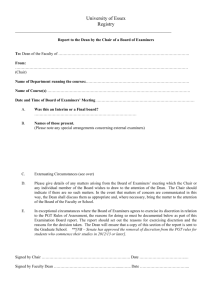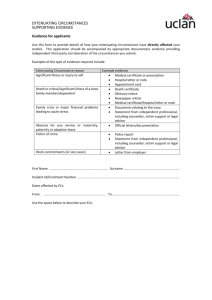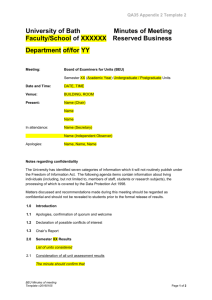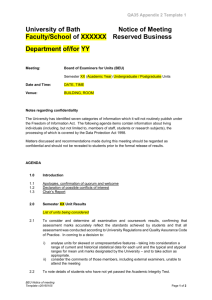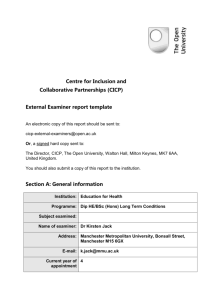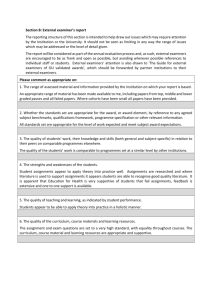procedure for extenuating circumstances
advertisement
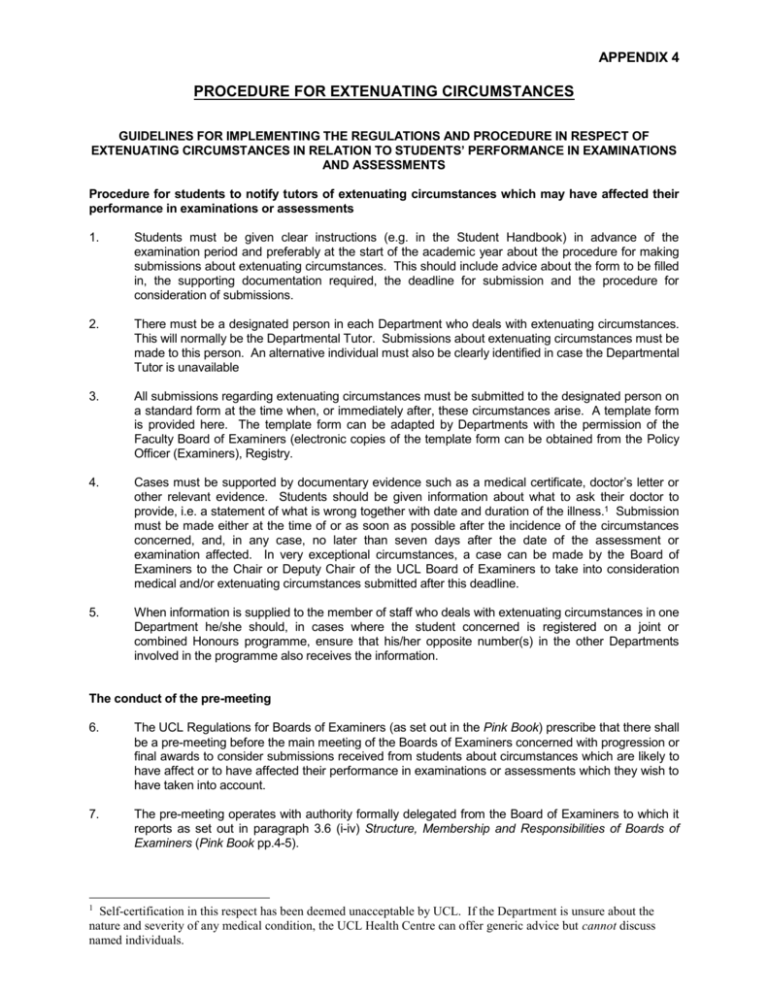
APPENDIX 4 PROCEDURE FOR EXTENUATING CIRCUMSTANCES GUIDELINES FOR IMPLEMENTING THE REGULATIONS AND PROCEDURE IN RESPECT OF EXTENUATING CIRCUMSTANCES IN RELATION TO STUDENTS’ PERFORMANCE IN EXAMINATIONS AND ASSESSMENTS Procedure for students to notify tutors of extenuating circumstances which may have affected their performance in examinations or assessments 1. Students must be given clear instructions (e.g. in the Student Handbook) in advance of the examination period and preferably at the start of the academic year about the procedure for making submissions about extenuating circumstances. This should include advice about the form to be filled in, the supporting documentation required, the deadline for submission and the procedure for consideration of submissions. 2. There must be a designated person in each Department who deals with extenuating circumstances. This will normally be the Departmental Tutor. Submissions about extenuating circumstances must be made to this person. An alternative individual must also be clearly identified in case the Departmental Tutor is unavailable 3. All submissions regarding extenuating circumstances must be submitted to the designated person on a standard form at the time when, or immediately after, these circumstances arise. A template form is provided here. The template form can be adapted by Departments with the permission of the Faculty Board of Examiners (electronic copies of the template form can be obtained from the Policy Officer (Examiners), Registry. 4. Cases must be supported by documentary evidence such as a medical certificate, doctor’s letter or other relevant evidence. Students should be given information about what to ask their doctor to provide, i.e. a statement of what is wrong together with date and duration of the illness.1 Submission must be made either at the time of or as soon as possible after the incidence of the circumstances concerned, and, in any case, no later than seven days after the date of the assessment or examination affected. In very exceptional circumstances, a case can be made by the Board of Examiners to the Chair or Deputy Chair of the UCL Board of Examiners to take into consideration medical and/or extenuating circumstances submitted after this deadline. 5. When information is supplied to the member of staff who deals with extenuating circumstances in one Department he/she should, in cases where the student concerned is registered on a joint or combined Honours programme, ensure that his/her opposite number(s) in the other Departments involved in the programme also receives the information. The conduct of the pre-meeting 6. The UCL Regulations for Boards of Examiners (as set out in the Pink Book) prescribe that there shall be a pre-meeting before the main meeting of the Boards of Examiners concerned with progression or final awards to consider submissions received from students about circumstances which are likely to have affect or to have affected their performance in examinations or assessments which they wish to have taken into account. 7. The pre-meeting operates with authority formally delegated from the Board of Examiners to which it reports as set out in paragraph 3.6 (i-iv) Structure, Membership and Responsibilities of Boards of Examiners (Pink Book pp.4-5). 1 Self-certification in this respect has been deemed unacceptable by UCL. If the Department is unsure about the nature and severity of any medical condition, the UCL Health Centre can offer generic advice but cannot discuss named individuals. 8. The constitution of the pre-meeting must include the Chair of the Board of Examiners (and/or his/her deputy or an approved alternate), at least one External Examiner for the programme or programmes concerned, an appropriate Departmental Tutor and the Departmental Examinations Liaison Officer. For Combined Honours programmes there must be appropriate representation from each Department contributing to the programme. If an External Examiner is unable to attend the pre-meeting, he/she must be formally consulted and be a party to the recommendations of the pre-meeting. 9. The extenuating circumstances meeting should take place shortly before the main Board of Examiners meeting; for practical purposes it is anticipated that it will normally take place on the same day as, and immediately prior to, the meeting of the Board of Examiners. 10. The pre-meeting will consider all submissions in full and make recommendations to the Board of Examiners according to the tariff specified in paragraph 27 below. Those recommendations must identify the courses, examinations or assessments to which they relate. The Chair of the Board of Examiners will be responsible for communicating the recommendations of the pre-meeting to the Board of Examiners. 11. The pre-meeting should only consider submissions which are submitted on the standard form and are supported by appropriate documentation. 12. The pre-meeting’s consideration of cases will be carried out without knowledge of the marks for the courses concerned. 13. Submissions relating to a condition which existed when a student entered UCL and which is stable should not normally be given particular weight. 14. The pre-meeting and/or the Board of Examiners can seek advice and further information on medical conditions from the UCL Health Centre but not in relation to particular individuals. 15. The pre-meeting will then use its judgement to score the extenuating circumstances according to a simple four-point scale that takes account of severity, duration and likely impact (see paragraph 27 below). The scale should be applied sensitively: it should be applied according to the perceived effect of the circumstances cited upon the individual concerned. It is possible for circumstances which prima facie appear similar to lead to different scores. 16. The scores may relate to a single course assessment or to whole diet of courses depending on whether the problem has been acute, chronic or acute but with a lasting impact. Although the Board of Examiners will only use the scores in relation to borderline candidates, scores must be decided for all candidates who submit extenuating circumstances forms since the pre-meeting will not be aware of the marks for the courses and candidates under consideration. 17. The deliberations and recommendations of the pre-meeting should be minuted and given or transmitted to the Chair of the Board of Examiners, but normally only the recommendations will be disclosed to the Board. Procedure at the meeting of the Board of Examiners 18. After the Board of Examiners has completed the academic assessment of the students’ marks it should consider extenuating circumstances. At this point in the meeting, the Board of Examiners will be aware of those candidates who are borderline cases, both at Pass/Fail, for other classification purposes and for progression. Extenuating circumstances scores should then be cited for the students in these categories alone. 19. The Chair of the Board of Examiners will inform the Board of all the candidates who have submitted information about extenuating circumstances. He/she will present the tariff scores recommended by the pre-meeting only of those candidates who are borderline in respect of degree awards, Pass/Fail or progression/non-progression. 20. The Chair will not normally inform the Board of the detail of individual cases, but the Board has the right to request and be given such detail to inform any particular decision. The Chair shall have discretion, in exceptional circumstances, to decline to give detail of the circumstances of any individual case. 21. Boards must be careful where concessions have already been granted to a student for an existing condition, e.g. the extension of a coursework deadline or extra time in an examination. Where such a student has been given an extenuating circumstances score for a condition on the basis of which he/she has already been granted special treatment (for one or more courses) this should be brought to the Board’s attention so that double consideration is avoided. 22. Where a final-year candidate successfully applied for extenuating circumstances and the outcome is to change the classification that he/she receives, it is preferable that the marks for the candidate should not be changed as it is undesirable to alter marks on non-academic grounds. 23. In the case of an Honours classification for a final-year undergraduate or a Pass/Distinction classification for a Master’s degree, the marks should not normally be changed. 24. However, in the case of an undergraduate where Pass/Fail, progression or qualification for Honours is an issue, the marks can be altered to obtain the desired result.2 For instance, if a student has a mark of 38, but, on the grounds of extenuating circumstances the Board wishes to award a Pass grade, the mark should be altered to 40 (i.e. a Pass). 25. Similarly, in the case of Master’s and Diploma students at the Pass/Fail borderline, the mark should be raised to 50%. 26. All decisions made by the Board must be appropriately minuted. Guide to applying extenuating circumstances scores 27. It is recommended that the numerical scores below would give a rough indication how far below a particular grade or Honours boundary a student’s mark might be considered: 3 – Severe physical or psychological distress that would be expected to be highly detrimental to a student’s academic performance (e.g. diagnosis of cancer; severe asthma; severe depression; death of a close relative). 2 – Medical circumstances or other circumstances where substantial impairment of a student’s performance would be expected. 1 – Less serious but still sufficient to impair a student’s academic performance (e.g. death of a distant relative; severe upper respiratory tract infection; hay fever; problems with personal relationships) 0 – Problems that are reasonably considered to be insignificant to the student’s academic performance. Extenuating circumstances guidelines (revised December 2004) 2 In cases where an accrediting professional body requires a specific pass mark on a course or courses to deem the candidate professionally competent, the Board may, at its discretion, make slight alterations to the mark appropriately. NOTIFICATION OF EXTENUATING CIRCUMSTANCES This is to enable the Board of Examiners to take into consideration any special circumstances that you believe may have affected your work. You should complete the form and then submit it, together with the accompanying documentation, to your Departmental Tutor (or other individual designated by your Department). You should retain a copy of all documentation. Section 1 NAME__________________________________________________YEAR__________________ DEPARTMENT____________________________________________________________ CONTACT (phone/email)___________________________________________________ COURSES TO WHICH EXTENUATING CIRCUMSTANCES APPLY (If all, state ‘ALL’) ________________________________________________________________________ Section 2 (a) MEDICAL CIRCUMSTANCES (To be completed by a medical practitioner or accompanied by medical certification. Continue on blank sheet provided if necessary) Give the nature and severity of the student’s medical condition and describe any consequences of the illness and/or treatment that may be relevant. Please provide the dates when the illness started and when the student was/will be fit to return to study. Signature of Medical Practitioner ____________________________Date _______________ (if appropriate) Medical Practitioner’s official Stamp : Section 2 (b) NON-MEDICAL CIRCUMSTANCES (To be completed by applicant. Continue on blank sheet provided if necessary) Give a brief description of the circumstances, accompanied by supporting documentation. Give the dates you were affected; an explanation of how the situation affected your study/examination performance; and what you have done about it. Have you already had consideration / extensions? What consideration are you requesting? Signature of Student ____________________________________Date _______________ NOTIFICATION OF EXTENUATING CIRCUMSTANCES NAME OF STUDENT_____________________________________________________________ DEPARTMENT____________________________________________________________ Continuation sheet (attach any supporting documentation here) Signature of Student ____________________________________Date ________________ Signature of Medical Practitioner ____________________________Date _______________ (if appropriate) Medical Practitioner’s official Stamp :
